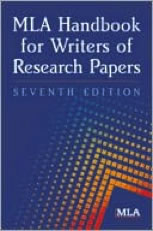Using Parenthetical Documentation
For more information on this topic, see the lesson “Documenting Sources and Writing a Bibliography/Works Cited.”

Source: MLA Handbook, Modern
Language Association of America,
Wikimedia Commons
When you use the work of others in your research papers and essays, it’s imperative that you acknowledge where you got your outside information. If you don’t, you could be accused of plagiarism. There are various ways to document sources. Your choice will depend on which writing style guide your class or school uses. Most English classes use MLA style, so that is the documentation style we demonstrate in these lessons. Other style guides include The Chicago Manual of Style and APA (Publication Manual of the American Psychological Association).
As I said in the introduction, the sources of all quotations must be identified with parenthetical documentation, also called in-text citation. If you directly quote someone’s spoken or written words, no matter how inconsequential they may seem, you must identify the source and the page number (if there is a page number).
Indirect quotations also require documentation. The only exception to this rule is an indirect quotation that consists of common knowledge; common knowledge does not need parenthetical documentation. How does somone know what information needs parenthetical documentation and what doesn’t?
Deciding when you need to give credit
|
Need to Give Credit in the Text |
Don’t Need to Give Credit in the Text |
Basically, if your information is obtained from somewhere else, or someone else, and isn’t something most people would know, |
If you’re unsure about citing information, go ahead and cite. |
See how well you can separate common knowledge from facts that should be cited. Choose the correct answer for each statement below.

Source: typpity-typpity. Amanky, Flickr
In the MLA documentation style, a short parenthetical citation is placed at the end of a quotation. This in-text citation refers the reader to the list of works cited for more complete information about the source. (The works cited list is called a bibliography by some other style guides.) Most citations consist of the author’s last name and a page number (for example: Smith 47).
For a complete list of the many parenthetical documentation possibilities, consult the newest edition of the MLA Handbook for Writers of Research Papers. Below are a few examples of how in-text MLA citation would look for certain sources:
- (257)
When the author’s name has already been mentioned in the sentence, use only the page number. - (Smith 47)
- (Smith and Jones 86)
- (“Bank Robbery” 8A)
- Smith writes that. . . .
To cite a source with no page numbers, or if an entire work is being acknowledged (a Web site or a film or song found online), it’s best to include the author’s name (or the title of the work, if the author’s name is not available) in your sentence instead of using parenthetical documentation.
To cite a book with one author, a signed encyclopedia article, a magazine article, an article from a scholarly journal, or a newspaper article, include the author’s last name, a space, and a page number.
To cite a book or article with more than one author, include the authors’ last names followed by the page number. When you list the names, use commas and “and” like you would in any other writing.
To cite a source with no author listed, include the first word or first two words of the title, excluding articles (a, an, the), and the page number.
Punctuating parenthetical citations
(or “Here We Go Again” With Exceptions to the Basic Punctuation Rules)
- Place a parenthetical citation before any punctuation required by the sentence. Periods and commas always go inside quotation marks unless there is parenthetical documentation, in which case periods and commas go after the documentation. For example, you would be correct to write a citation like this:
- The ending punctuation of a block quotation comes before the parenthetic documentation. The block quotation from Zen and the Art of Motorcycle Maintenance in the third section of this lesson, “Embedding Direct Quotations,” demonstrates this.
—She said, “Hurry up” (Thomas 14).
The exception itself actually has an exception. If you cite a sentence that ends with a question mark or exclamation point, use the exclamation point or question mark inside the closing quotation mark, and follow the quotation mark with the documentation and a period. For example:
—The doctor asked, “What is a human life worth?” (Lowe 391).